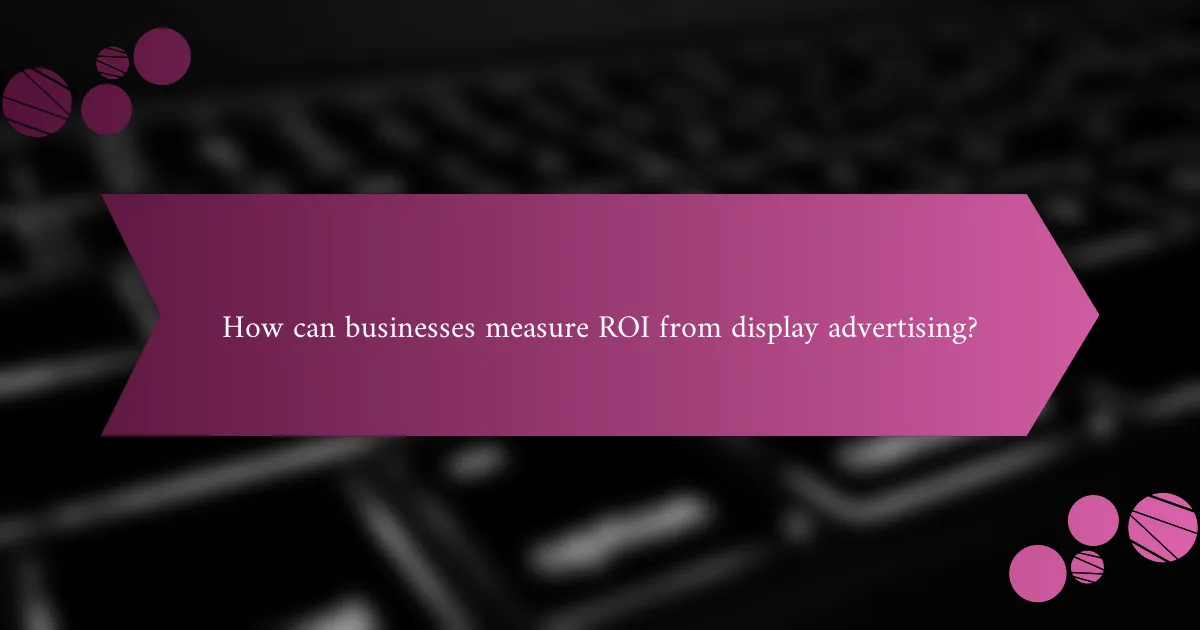Display advertising has evolved significantly with the advent of programmatic buying, which automates the ad purchasing process and enables real-time adjustments for better targeting. By utilizing data and algorithms, advertisers can optimize their ad placements, leading to enhanced efficiency and improved return on investment (ROI). This technology-driven approach allows businesses to make informed decisions and measure the effectiveness of their campaigns more accurately.

How does programmatic buying enhance display advertising in the US?
Programmatic buying significantly enhances display advertising in the US by automating the purchasing process, allowing for real-time adjustments and improved targeting. This method leverages data and algorithms to optimize ad placements, ultimately increasing the return on investment (ROI) for advertisers.
Real-time bidding efficiency
Real-time bidding (RTB) allows advertisers to bid on ad space in milliseconds, ensuring that the most relevant ads reach the right audience at the right time. This efficiency reduces wasted impressions and maximizes the impact of advertising budgets. For example, an advertiser can set parameters to bid only on specific demographics or behaviors, ensuring their ads are shown to users most likely to convert.
To maximize RTB efficiency, consider using automated bidding strategies that adjust based on performance metrics. Regularly review and refine your bidding parameters to align with changing market conditions and audience behavior.
Targeted audience reach
Programmatic buying enables precise targeting by utilizing vast amounts of data to identify and reach specific audience segments. Advertisers can target based on demographics, interests, online behavior, and even geographic location, increasing the likelihood of engagement. For instance, a local restaurant can target users within a certain radius who have shown interest in dining out.
To enhance audience targeting, utilize tools that analyze user data and behavior patterns. Regularly update your audience segments based on campaign performance to ensure you are reaching the most relevant users.
Cost-effectiveness
Programmatic buying can be more cost-effective than traditional advertising methods, as it allows for better budget allocation and reduced overhead costs. Advertisers can set daily or campaign budgets and adjust bids in real-time based on performance, ensuring they only spend on ads that deliver results. Many businesses report achieving lower cost-per-acquisition (CPA) rates through programmatic channels.
To ensure cost-effectiveness, monitor your campaigns closely and analyze performance metrics regularly. Avoid common pitfalls such as overspending on underperforming ads by implementing strict budget controls and utilizing A/B testing to identify the most effective ad creatives and placements.

What are the key benefits of automation in display advertising?
Automation in display advertising offers significant advantages, including enhanced efficiency, better targeting, and improved return on investment (ROI). By leveraging technology, advertisers can streamline processes and make data-driven decisions that lead to more effective campaigns.
Increased ad placement speed
Automation allows for rapid ad placement, enabling advertisers to react quickly to market changes and consumer behavior. This speed is crucial in a fast-paced digital environment where timely ads can capitalize on trends and events.
For instance, programmatic buying can place ads in real-time, often within milliseconds, ensuring that the right message reaches the right audience at the optimal moment. This efficiency can lead to higher engagement rates and better overall performance.
Improved campaign optimization
Automated systems analyze vast amounts of data to optimize campaigns continuously. This means that ads can be adjusted in real-time based on performance metrics, such as click-through rates and conversions.
Advertisers can set specific goals, and the automation tools will work to achieve those targets by reallocating budgets, changing ad placements, or modifying creative elements. This dynamic approach often results in higher ROI as resources are directed toward the most effective strategies.
Reduced manual errors
Manual processes in display advertising can lead to mistakes that waste budgets and diminish campaign effectiveness. Automation minimizes these errors by standardizing procedures and using algorithms to execute tasks accurately.
For example, automated bidding strategies can prevent overspending by ensuring that bids are placed according to pre-defined parameters. This reliability not only saves money but also allows marketers to focus on strategic planning rather than day-to-day management.

How can businesses measure ROI from display advertising?
Businesses can measure ROI from display advertising by analyzing the revenue generated against the costs incurred for ad placements. This involves tracking conversions, understanding customer behavior, and applying various analytical techniques to assess effectiveness.
Attribution modeling techniques
Attribution modeling techniques help businesses determine which touchpoints in the customer journey contribute to conversions. Common models include first-click, last-click, and multi-touch attribution, each offering different insights into how ads influence purchasing decisions.
For example, a last-click model attributes all credit to the final ad a customer interacted with before making a purchase, while multi-touch models distribute credit across multiple interactions. Choosing the right model depends on the business goals and the complexity of the customer journey.
Conversion tracking tools
Conversion tracking tools are essential for measuring the effectiveness of display advertising campaigns. These tools, such as Google Analytics or Facebook Pixel, allow businesses to monitor user actions after engaging with ads, providing data on clicks, sign-ups, and sales.
To implement conversion tracking, businesses should set clear conversion goals, integrate tracking codes on their websites, and regularly analyze the data to optimize their ad strategies. This helps in understanding which ads drive the most valuable actions.
Customer lifetime value analysis
Customer lifetime value (CLV) analysis estimates the total revenue a business can expect from a customer throughout their relationship. Understanding CLV is crucial for evaluating the ROI of display advertising, as it helps businesses determine how much they can afford to spend on acquiring new customers.
To calculate CLV, businesses can use the formula: CLV = Average Purchase Value x Purchase Frequency x Customer Lifespan. By comparing CLV to customer acquisition costs, businesses can assess the profitability of their display advertising efforts and make informed budget decisions.

What criteria should be considered when choosing programmatic platforms?
When selecting programmatic platforms, focus on reputation, integration capabilities, and data privacy compliance. These factors can significantly impact the effectiveness and security of your advertising efforts.
Platform reputation and reliability
Assessing a platform’s reputation involves researching its history, user reviews, and case studies. Reliable platforms often have a track record of successful campaigns and positive feedback from advertisers.
Consider platforms that are recognized in the industry and have partnerships with reputable ad exchanges. This can enhance your campaign’s reach and performance.
Integration capabilities
Integration capabilities refer to how well the programmatic platform connects with your existing marketing tools and data sources. A platform that easily integrates with Customer Relationship Management (CRM) systems or analytics tools can streamline your workflow.
Look for platforms that support APIs or have pre-built connectors to popular marketing software. This can save time and reduce the complexity of managing multiple systems.
Data privacy compliance
Data privacy compliance is crucial in today’s advertising landscape, especially with regulations like GDPR and CCPA. Ensure the programmatic platform adheres to these standards to protect user data and avoid legal issues.
Choose platforms that provide transparent data handling practices and allow you to manage user consent effectively. This not only builds trust but also enhances your brand’s reputation.

What are the emerging trends in display advertising?
Emerging trends in display advertising include the rise of AI-driven ad personalization and a heightened focus on privacy regulations. These trends are reshaping how advertisers engage with audiences and manage data, making it essential to adapt strategies accordingly.
AI-driven ad personalization
AI-driven ad personalization tailors advertisements to individual user preferences and behaviors, enhancing engagement and conversion rates. By analyzing vast amounts of data, AI can predict what content will resonate with specific audiences, leading to more effective campaigns.
To implement AI-driven personalization, consider using machine learning algorithms that analyze user interactions and demographics. For example, e-commerce platforms often use AI to recommend products based on past purchases, significantly increasing the likelihood of additional sales.
Increased focus on privacy regulations
The increasing focus on privacy regulations is reshaping display advertising practices. Laws such as the GDPR in Europe and CCPA in California impose strict guidelines on how user data can be collected and utilized, pushing advertisers to prioritize transparency and consent.
To comply with these regulations, businesses should ensure clear communication about data usage and obtain explicit consent from users. Implementing privacy-first strategies not only mitigates legal risks but can also enhance brand trust and customer loyalty.









